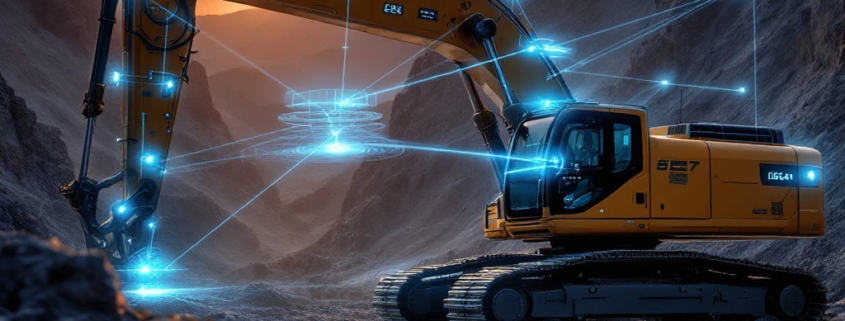What Innovations Are Advancing Off-Highway Vehicle Automation?
The off-highway sector is experiencing a technological revolution through autonomous systems that boost efficiency, safety, and productivity. Advanced sensor technologies, robust communication networks, artificial intelligence algorithms, and enhanced safety systems are collectively transforming how industrial vehicles operate. These innovations enable equipment to perceive environments, communicate between components, make intelligent decisions, and operate safely with minimal human intervention. For industrial applications in mining, agriculture, and construction, these technologies are creating smarter, more efficient operations while addressing labor shortages and improving worker safety.
Understanding the evolution of off-highway vehicle automation
The journey toward autonomous off-highway vehicles has been marked by progressive advances over several decades. Early automation began with basic operator assistance features like automated transmission systems and hydraulic controls that reduced operator fatigue while improving precision. As technology advanced, these systems evolved into more sophisticated machine control capabilities.
The 1990s and early 2000s saw significant progress with the introduction of GPS-guided systems in agriculture, allowing for precise field navigation and reduced input waste. Mining operations began implementing semi-autonomous haulage systems, enabling trucks to follow predefined routes with minimal operator intervention.
Today’s advanced autonomous systems can perform complex tasks with little to no human supervision. The progression has been driven by several factors, including the need to address labor shortages, improve safety in hazardous environments, enhance operational efficiency, and reduce environmental impact. In industries like mining, construction, and agriculture, autonomous equipment is increasingly becoming standard rather than exceptional.
This technological evolution has delivered tangible benefits: increased productivity through 24/7 operations, improved fuel efficiency, reduced maintenance costs, and enhanced worker safety by removing humans from dangerous environments. As these systems continue to mature, they’re fundamentally transforming industrial operations across multiple sectors.
How are CAN bus systems revolutionizing off-highway vehicle communication?
CAN bus technology serves as the critical nervous system enabling advanced automation in off-highway vehicles. This robust communication framework allows multiple electronic control units (ECUs) to exchange data without a central computer, creating resilient networks particularly suited for harsh industrial environments where reliability is paramount.
The technology enables real-time data transmission between critical vehicle components including engines, transmissions, hydraulic systems, and operator interfaces. This seamless communication supports automated functions through a standardized protocol that simplifies integration while reducing wiring complexity and associated maintenance issues.
Modern CAN bus networks in off-highway equipment can support hundreds of parameters simultaneously, from engine temperature to implement position, creating a comprehensive operational picture. The technology’s inherent fault tolerance and error detection capabilities ensure communication integrity even when operating in challenging conditions with extreme temperatures, vibration, and dust.
As automation advances, these networks increasingly incorporate gateway modules that bridge traditional CAN systems with newer protocols like Ethernet, facilitating higher data throughput needed for advanced autonomous operations. This evolutionary approach allows manufacturers and operators to progressively enhance capabilities while protecting existing investments in fleet equipment.
What sensor technologies are driving autonomous capabilities in off-highway equipment?
The autonomous functionality of off-highway vehicles depends critically on a sophisticated array of sensor technologies that collectively create environmental awareness. These systems must perform reliably in challenging conditions including dust, vibration, extreme temperatures, and varied lighting.
LiDAR (Light Detection and Ranging) technology provides high-precision 3D mapping of surroundings by emitting laser pulses and measuring their return time. This capability enables accurate obstacle detection and terrain mapping, though manufacturers continue working to improve durability and dust resistance for industrial applications.
Radar systems complement LiDAR by offering superior performance in adverse weather and dusty conditions. They excel at detecting moving objects and measuring velocities, making them ideal for collision avoidance systems. Meanwhile, high-definition cameras provide visual information for object recognition and classification, often enhanced by infrared capabilities for low-light operation.
Additional sensing technologies include ultrasonic sensors for close-range detection, inertial measurement units for accurate positioning when GPS signals are unavailable, and specialized implements sensors that monitor the status of attachments. The integration of these diverse sensors through sensor fusion algorithms creates redundancy that ensures reliable operation even if individual sensors are compromised.
As these technologies continue maturing, they’re becoming more compact, energy-efficient, and cost-effective, accelerating adoption across various off-highway applications from precision agriculture to autonomous mining operations.
How is artificial intelligence transforming off-highway vehicle operation?
Artificial intelligence represents the cognitive layer that converts raw sensor data into meaningful operational decisions for autonomous off-highway vehicles. Machine learning algorithms enable equipment to recognize patterns, adapt to changing conditions, and improve performance over time without explicit programming for every scenario.
Predictive maintenance applications analyze operational data to identify potential component failures before they occur, reducing costly downtime and extending equipment lifespan. These systems monitor parameters like oil pressure, temperature patterns, and vibration signatures to detect subtle changes indicating developing issues.
Path planning and optimization algorithms calculate efficient routes through worksites, considering terrain challenges, operational priorities, and the location of other equipment. This optimization reduces fuel consumption, minimizes wear on components, and increases overall productivity by eliminating inefficient movement patterns.
Adaptive control systems continuously adjust operational parameters based on real-time conditions. For example, an autonomous excavator might modify its digging approach when encountering unexpected soil conditions, while a smart agricultural sprayer could adjust application rates based on plant health indicators detected through computer vision.
The integration of edge computing in modern off-highway equipment allows these AI systems to process critical data locally, ensuring rapid response times for safety-critical functions while still enabling cloud connectivity for fleet-wide optimization and analysis.
What safety innovations are essential for autonomous off-highway vehicles?
Safety systems form the foundation of autonomous off-highway vehicle deployment, with redundancy and fail-safe mechanisms being fundamental design principles. Multiple layers of protection ensure that equipment can detect potential hazards, respond appropriately, and default to a safe state if anomalies occur.
Advanced collision avoidance systems employ multiple sensing technologies to create overlapping detection zones around vehicles. These systems continuously monitor for obstacles and can automatically initiate emergency stops or evasive maneuvers when threats are identified. The response protocols typically incorporate graduated measures, from slowing operation to complete shutdown depending on proximity and risk assessment.
Remote monitoring capabilities enable human supervisors to maintain situational awareness of autonomous operations from a safe distance. These systems provide real-time telemetry, video feeds, and alert notifications, allowing operators to intervene if necessary or validate autonomous decisions in complex scenarios.
Geofencing technology creates virtual boundaries that restrict equipment operation to designated areas, preventing unintended movement into unsafe zones or areas with human workers. These systems often incorporate dynamic updates based on worksite conditions, allowing for flexible but controlled autonomous operation.
Functional safety standards like ISO 13849 and IEC 61508 provide frameworks for validating safety systems, with certification processes ensuring rigorous testing before deployment. As autonomous systems become more prevalent, regulatory standards continue evolving to address the unique challenges of self-operating industrial equipment.
The future of off-highway vehicle automation: Key takeaways
The trajectory of off-highway automation points toward increasingly sophisticated systems with greater autonomy and integration. Current development focuses on enhancing inter-vehicle communication, allowing multiple autonomous machines to coordinate activities across worksites without human intervention.
Energy efficiency will drive innovation as manufacturers develop intelligent power management systems that optimize operation for reduced fuel consumption and emissions. Parallel efforts in electrification complement automation technologies, with battery-electric and hydrogen fuel cell vehicles increasingly incorporating autonomous capabilities.
Data integration across entire operations will enable holistic optimization beyond individual machines. This systems approach will connect autonomous equipment with production planning, maintenance scheduling, and logistics to create synchronized workflows that maximize overall efficiency.
For companies looking to leverage these technological advances, partnering with experienced automation specialists becomes essential. TK Engineering’s deep expertise in CAN bus technology and control systems provides the foundation for implementing robust automation solutions. Our approach focuses on scalable systems that allow companies to progressively enhance capabilities while maintaining operational reliability.
As autonomous technologies continue maturing, the competitive advantage will increasingly belong to organizations that successfully integrate these innovations into their operations. The result will be safer, more efficient, and more productive industrial applications across mining, construction, agriculture, and other off-highway sectors.
See how technology powers performance off the beaten path.
Our off-highway case stFudies reveal how advanced control systems and CAN communication optimize operations in demanding terrain and conditions.



